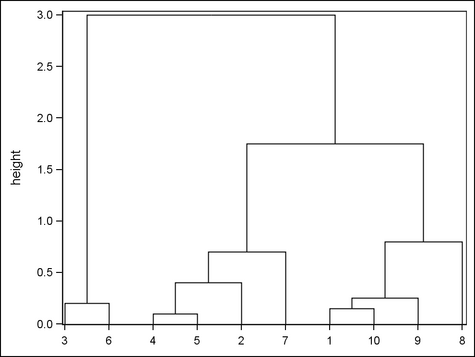Example Program and Statement Details
Example Program
data clustree;
input id $ parent $7-12 height nClus;
label id="Cluster ID" parent="Parent ID";
datalines;
clus1 3 1
clus2 clus1 0.2 7
clus3 clus1 1.75 2
clus4 clus3 0.7 4
clus5 clus3 0.8 3
clus6 clus4 0.4 5
clus7 clus6 0.1 9
clus8 clus5 0.25 6
clus9 clus8 0.15 8
1 clus9 0 10
2 clus6 0 10
3 clus2 0 10
4 clus7 0 10
5 clus7 0 10
6 clus2 0 10
7 clus4 0 10
8 clus5 0 10
9 clus8 0 10
10 clus9 0 10
run;
proc template;
define statgraph dendrogram;
begingraph;
layout overlay;
dendrogram nodeID=id parentID=parent clusterheight=height;
endlayout;
endgraph;
end;
run;
proc sgrender data=clustree template=dendrogram;
run;Statement Summary
A dendrogram is a tree
diagram that is typically used to show the cluster arrangements in
hierarchical data. The DENDROGRAM statement supports clusters with
only a single root. If multiple roots are found in the data, a warning
is issued to the SAS log and the dendrogram is not drawn.
Required Arguments
specifies a column
for the ID values of the nodes. Each node ID value must be unique.
If duplicate NODEID values are found, the dendrogram is not rendered
. The column can be numeric
or character, but it must be of the same type and have the same formatted
length as the PARENTID column.
The maximum number of nodes that are
supported by the dendrogram is determined by the DISCRETEMAX= option
in the ODS GRAPHICS statement. The default value is DISCRETEMAX=1000.
If the graph data contains more than 1000 discrete values, the dendrogram
is not drawn and a warning is issued to the SAS log. In that case,
you can use the DISCRETEMAX= option to increase the maximum number
of discrete values that are allowed.
Options
specifies pruning options
for cutting the dendrogram.
The following pruning-options must
be specified as a list of option = value pairs
separated by blanks. The list must be enclosed in parentheses.
specifies the attributes
of the cut lines. See General Syntax for Attribute Options for the syntax
on using a style-element and Line Options for available line-options.
specifies the attributes
of the dendrogram lines. See General Syntax for Attribute Options for the syntax
on using a style-element and Line Options for available line-options.
specifies that the
data columns for this plot be used for determining default axis features.
Details: This
option is needed only when two or more plots within an overlay-type
layout contribute to a common axis. For more information, see When Plots Share Data and a Common Axis.
specifies user-defined
roles that can be used to display information in the tooltips.
Requirement: The
role names that you choose must be unique and different from the pre-defined
roles NODEID, PARENTID, and CLUSTERHEIGHT.
This option provides
a way to add to the data columns that appear in tooltips, which are
specified by the TIP= option.
specifies the information
to display when the cursor is positioned over a dendrogram line. If
this option is used, it replaces all the information displayed by
default. Roles for columns that do not contribute to the dendrogram
plot can be specified along with roles that do.
Default: The
columns assigned to the following roles are automatically included
in the tooltip information: NODEID, PARENTID , and CLUSTERHEIGHT.
an ordered, blank-separated
list of unique DENDROGRAM and user-defined roles. DENDROGRAM roles
include NODEID , PARENTID , and CLUSTERHEIGHT.
User-defined roles
are defined with the ROLENAME= option.
Requirement: To
generate tooltips, you must include an ODS GRAPHICS ON statement that
has the IMAGEMAP option specified, and write the graphs to the ODS
HTML destination.
Interaction: The
labels and formats for the TIP variables can be controlled with the TIPLABEL= and TIPFORMAT= options.
specifies display formats
for information defined by the tooltip roles.
Requirement: This
option provides a way to control the formats of columns that appear
in tooltips. Only the roles that appear in the TIP= option are used.
Columns must be assigned to the roles for this option to have any
effect. See the ROLENAME= option.
specifies display labels
for information defined by the tooltip roles.
Requirement: This
option provides a way to control the labels of columns that appear
in tooltips. Only the roles that appear in the TIP= option are used.
Columns must be assigned to the roles for this option to have any
effect. See the ROLENAME= option.
specifies whether data
are mapped to the primary X (bottom) axis or to the secondary X2 (top)
axis.
Interaction: The
overall plot specification and the layout type determine the axis
display. For more information, see How Axis Features Are Determined.
specifies whether data
are mapped to the primary Y (left) axis or to the secondary Y2 (right)
axis.
Interaction: The
overall plot specification and the layout type determine the axis
display. For more information, see How Axis Features Are Determined.
